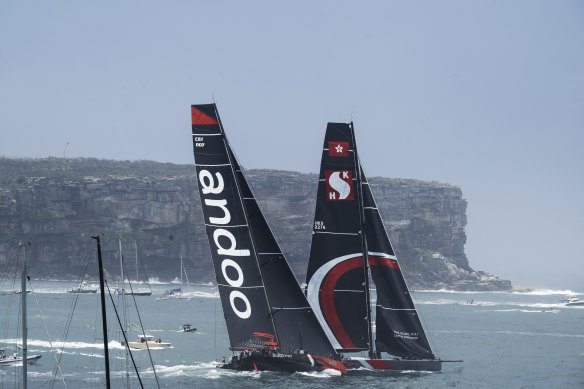- Analysis
- Sport
- Sailing
- Sydney to Hobart
This was published 10 months ago
Clash of the titans: A box seat at the start of the Sydney to Hobart ‘sword fight’
By Emma Kemp
They said they would get us close, but we didn’t realise it would be quite that close. The skipper of our media boat didn’t either, based on his banter once he had steered us back to dry land. “Couple of hairy moments and small spaces,” were his exact words.
One of those small spaces was effectively in front of Andoo Comanche and Scallywag, with the latter looking certain to hit the former coming through the Sydney Heads. Just off to the left, craning our necks over starboard to watch as one behemoth of a boat headed straight for another. Neck and neck. Calling out things that make you understand what it means to swear like a sailor.
The verbal jostling ended with a call of “protest” from the deck of Andoo Comanche, and the raising of a red flag. With that, last year’s line honours winner put her Hong Kong-based rival on notice, declaring she had tacked too close and would have to pay.
“It’s a classic port-and-starboard [incident], that’s too close,” Andoo Comanche sailing master Iain Murray told the Seven Network as it went down. “You can’t do that with 100-footers.”
Would Scallywag make two pre-emptive penalty turns, or would she take her chances with the jury post-race?
Wild Oats XI found out the hard way in 2017, when she was retrospectively found to have breached the rules over a tacking manoeuvre and near-collision with Comanche at the start. The one-hour penalty gifted line honours to Comanche, who had finished 27 minutes slower.
Scallywag wasn’t feeling fortunate – she made her 720-degree turn off the shore of Bondi Beach, and then retired with a broken bow sprit several hours later.
All we saw, though, were giant masts in a sword fight and flapping sails on a rolling swell. The media boat outpaced the frontrunners to ensure the vantage point. TV reporters with microphones balanced precariously to capture the drama unfolding behind them, almost doing the splits to stay upright as the vessel rocked and lurched. Somebody held the scruff of a cameraman’s neck to keep him and his equipment from doing a runner.

Scallywag and Andoo Comanche during the start of the 2023 Sydney to Hobart Yacht race.Credit: Louise Kennerley
Other camera crew deliberately jumped off the supermaxis into the water, their job capturing the action close-up done for the day and no desire to make the full pilgrimage to Hobart. A photographer jumped into the water to get the money-shot. A media chopper swooped down from above and hovered three metres above the swell to capture precious close-up footage.
LawConnect, whose owner Christian Beck had just this morning called his boat “a s---box compared to Comanche”, took advantage of the kerfuffle and scooted past and out of the heads. Last year’s runner-up had been fastest off the line, but slowed down making a turn off course to remedy an issue furling a sail.
For a moment, everyone forgot there was a fourth supermaxi competing, then searched for and found Wild Thing 100. For the first half-hour most forgot any boats outside the big four even existed. But then they came, from the 52-footers right down to the smallest: the 30-foot Currawong and Sylph VI.
And then you remember that Sylph VI is also the oldest, having been built in 1960. And, oh yeah, there is also a cat on board.
“Oli has crashed out on the starboard settee, with his head on the pillow – he looks very peaceful,” owner and skipper Bob Williams told the Seven Network. “We’re where we expected to be: at the back of the fleet. It’s bouncy conditions, but we’ve got a bit of breeze and we still have the fleet in sight.”
Then of course you wonder why, if Oli the cat is sleeping peacefully in the galley, the thought of putting your own head down anywhere makes you want to barf. It is choppy, but not by Sydney to Hobart standards. The thunder says it will be soon, though.
It was raining even before the starting cannon sounded, heralded by a lightning bolt that jolted boat crews into their wet-weather gear and the fancier-dressed spectators inside. Even through the brief-but-torrential downpour, the thousands of dots stationed on the grass at South Head did not shift from their viewing platform.
When it was done, they were rewarded with blue skies and light winds. For the sailors, it was an eerie precursor, given the forecast of rain, strong and erratic winds, and even hail. Hairy moments and small spaces ahead.